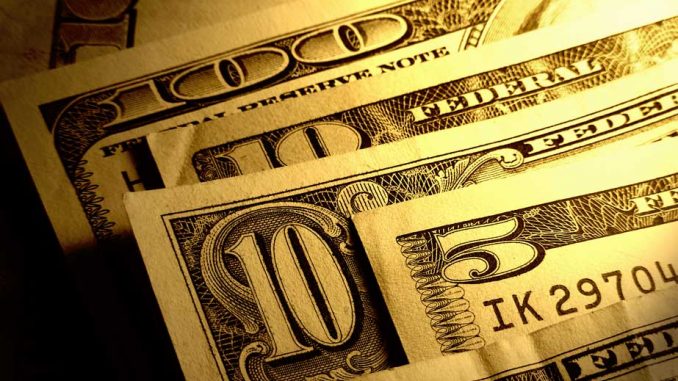
Back in May, Donald Trump has tweeted this:
As long as other countries are receiving the benefits of Negative Rates, the USA should also accept the “GIFT”. Big numbers!
— Donald J. Trump (@realDonaldTrump) May 12, 2020
…and with the Federal Reserve pretty much emptying its inventory of monetary policy tools when it did this:
…and with the economy needing some sort of intervention to prevent an even deeper and longer economic contraction, it looks like the Fed will have to use hitherto untested and experimental monetary medicine to get the economy back on its feet once the COVID-19 panic is over.
Thanks to the International Monetary Fund, the braintrust at the Federal Reserve has a roadmap for its future stimulation policies. Back in April 2019, authors Ruchir Agarwal and Miles Kimball released a working paper entitled "Enabling Deep Negative Rates to Fight Recessions: A Guide" as shown here:
In this paper, the authors open by noting that a lower bound (i.e. zero percent interest aka the zero lower bound or ZLB) can be a significant obstacle to fighting recessions. This is particularly the case in our current ultra low interest rate environment which has left the Federal Reserve with almost no room to manoeuvre. The authors note that the zero lower bound is "…not a nature of law; it is a policy choice…" and that deeply negative interest rates are one tool that can be used by central banks to end recessions in a short period of time. In the authors' opinion, this is preferable to using mildly negative interest rates for a short period of time which may result in a longer period of economic recovery.
In the past, the Federal Reserve and other influential central banks including the Bank of Japan, the Bank of England and the European Central Bank have been able to cut interest rates significantly during economic contractions as shown on this graphic:
On average, central banks have been able to cut interest rates by between 5 percentage points and 6 percentage points during recessions as you can see on this graph showing the Federal Funds Rate going back to 1965:
Clearly, this is no longer possible with the world's key central banks having interest rates that are nearly zero (or less) at this point in time.
As it stands now, the public obtains cash from a commercial bank using an ATM or by cashing cheques. Commercial banks get their cash from the central bank through an account that they hold on reserve with the central bank by using the central bank's "cash window". This cash window allows the banks to exchange electronic currency for paper currency which is shipped from the central bank's cash offices. In the current system, the central bank treats a 100-dollar note as an equivalent to 100-electronic dollars and does not charge any substantial fees for the issuance or acceptance of paper currency (i.e. a zero percent interest rate on currency). The authors note that this does not have to be the case; central banks could choose to charge a non-zero paper currency interest rate.
How can central banks impose a deeply negative interest rate policy, noting that electronic money refers to credit balances in an account held in the books of the central bank or commercial bank? There are two methods:
1.) "The Clean Approach" – an electronic money system that takes paper currency off par with electronic money. For example, using this mechanism, if the central bank wished to implement a negative interest rate policy, it could do so as follows:
"...the central bank could gradually phase out $100 bills by every year deducting $1 from what it would give in exchange for a $100 bill: after one year, $99, after two years, $98 and so on. If that is how the central bank treated a paper $100 bill at the cash window, that is what it would be worth…"(i.e. the central bank would be lowering the value of a paper bill when compared to an electronic dollar, essentially resulting in a negative interest rate).
In this scenario, retailers who accept both cash and credit cards could apply a paper currency surcharge to any transactions where customers use cash. The advantage to this system is that no extra regulations are required since the impact on the economy works entirely thought the price system by imposing a negative rate of return on paper currency anywhere since it cash is only accepted at a discount.
2.) "The Rental Fee Approach" – an approach which keeps paper currency at par with electronic money within the financial system and the large corporate sector. The central bank could generate a non-zero paper currency interest rate through the imposition of an "x" percent per annual rental fee for commercial banks withdrawing paper currency from the cash window. For example, if a commercial bank withdrew a $100 bank note from the central bank, in addition to being debited the $100 from its reserve account by the central bank, it would also pay "x" dollars as a yearly rental fee to the central bank, thus creating a negative interest rate on cash. To avoid inconveniencing households, the central bank could set an exemption amount which would allow banks to withdraw amounts up to the net withdrawal of paper currency on behalf of its customers up to a per-customer and per-month limit, thus preventing large scale withdrawals. Both the Swiss National Bank and the Bank of Japan have adopted somewhat altered versions of this approach.
Here is a table showing the side effects of the rental fee approach:
In both cases, the authors recommend that the transmission of negative paper currency interest rates should fall to the commercial banks since they have far more experience dealing firsthand with customer relations problems than central banks.
Obviously, there will be a reduction in the circulation of paper currency as a result of these two approaches. Let's look at a quote from the paper:
"If households can’t readily sell it at a premium, they will have incentives to hoard paper currency, instead of using it as a medium of exchange. This in turn will lead to reduced circulation of paper currency in the system. This could be burdensome and costly for some households and small businesses, especially for those that rely heavily on cash transactions. On the other hand, a silver lining of reduced circulation of paper currency would be that it encourages electronic transactions and the adoption of technology that facilitates electronic transactions. By raising the fraction of electronic transactions—and encouraging irreversible investments in digital payment systems—the Gresham’s Law effect would make it easier for the central bank to use the clean approach based on an electronic unit of account at a later date.
Another silver lining of the Gresham’s Law effect would be making law enforcement easier. While many individuals use paper currency for perfectly legal purposes (and some may even have an ‘irrational’ preference for cash), an important part of the demand for paper currency is driven by the desire to keep secrets from the government. As Ken Rogoff (2016) puts it, in addition to the legal tax- paying domestic economy, the sources of demand for cash include the (a) not-so-law-abiding domestic underground economy—including both tax evasion and criminal activities, and (b) the global economy, including both legal and illegal demand. Imposing a rental fee on cash withdrawals does. Imposing a rental fee on cash withdrawals does not eliminate the freedom to use cash, but makes large-scale murky cash withdrawals stand out more, thereby facilitating law enforcement." (my bold)
Let's close with these thoughts from the authors:
"Our view is that, when needed, deep negative rates are likely to be worth the political cost. After all, when facing a deep recession with little room to cut rates in the positive region, the choice is not between political calm for a central bank or a political storm for the central bank, but the political cost of negative rates on one hand weighed on the other hand against the opprobrium a central bank justifiably comes under when it fails to fulfil its mandate and return the economy to normal in a timely way. Nevertheless, reducing political costs where that is consistent with sweeping away any lower bound on interest rates is not only directly helpful, but also makes the financial markets more likely to believe that the central bank will be bold enough to pursue a vigorous negative interest rate policy."
Given that the Federal Reserve has dropped its key rate to near zero and further bloated its already morbidly obese balance sheet as shown here:
…we can pretty much assure ourselves that, at the very least, a negative interest rate environment is not far off. As yet, there has not been any experience with interest rates below -1 percent, however, given the current moribund state of the global economy, that is not likely to hold true for very long.
Click HERE to read more from this author.
You can publish this article on your website as long as you provide a link back to this page.

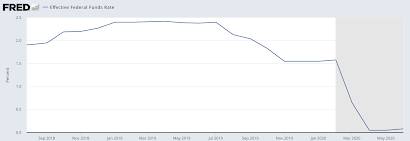
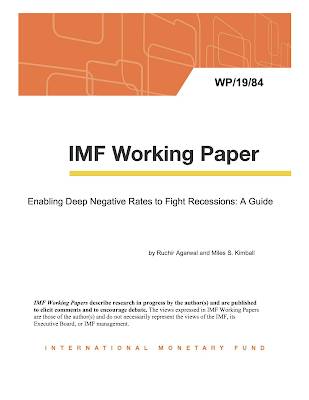
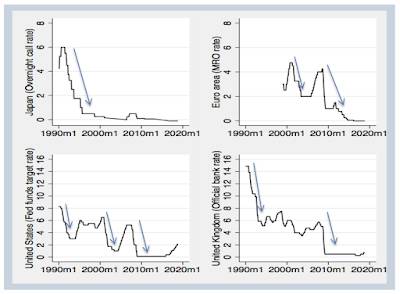
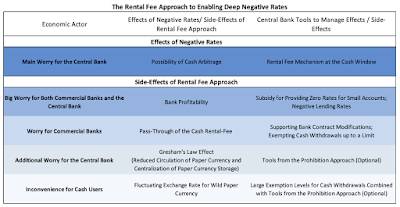
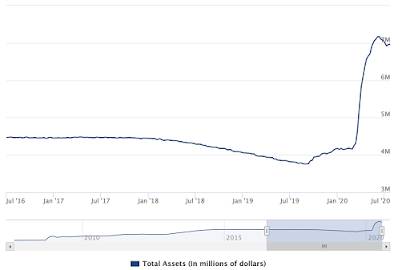
Be the first to comment